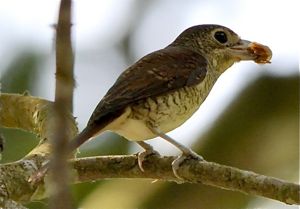The Tiger Shrike (Lanius tigrinus) is a common winter migrant at the Kledang-Sayong Forest Reserve in Perak, Malaysia. On 27th November 2009, Dato’ Dr Amar-Singh HSS encountered a first winter juvenile. The bird had what looks like a large forest cockroach (Pseudophoraspis nebulosa) in its bill.
The shrike simply swallowed the prey whole without first dismembering it, as personally witnessed by Amar on a number of occasions in his garden as well as in the wild. Then, the shrikes ate large grasshoppers and praying mantises whole.
The literature however mentions the shrike first dismembering the prey to eat the pieces. We have also posted accounts of the shrike dismembering a beetle and a cicada before eating.
“This bird became very ‘friendly’ after eating and allowed a closer approach,” recounts Amar.
.
.
.










